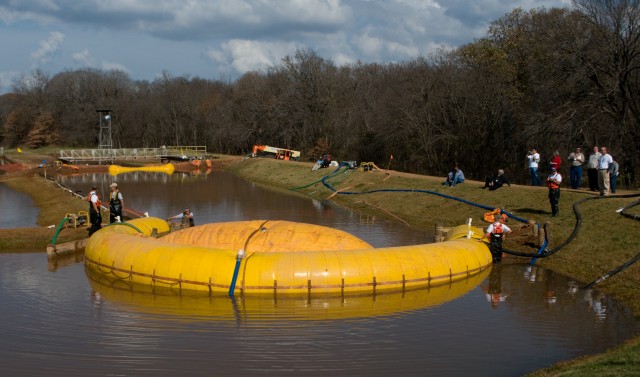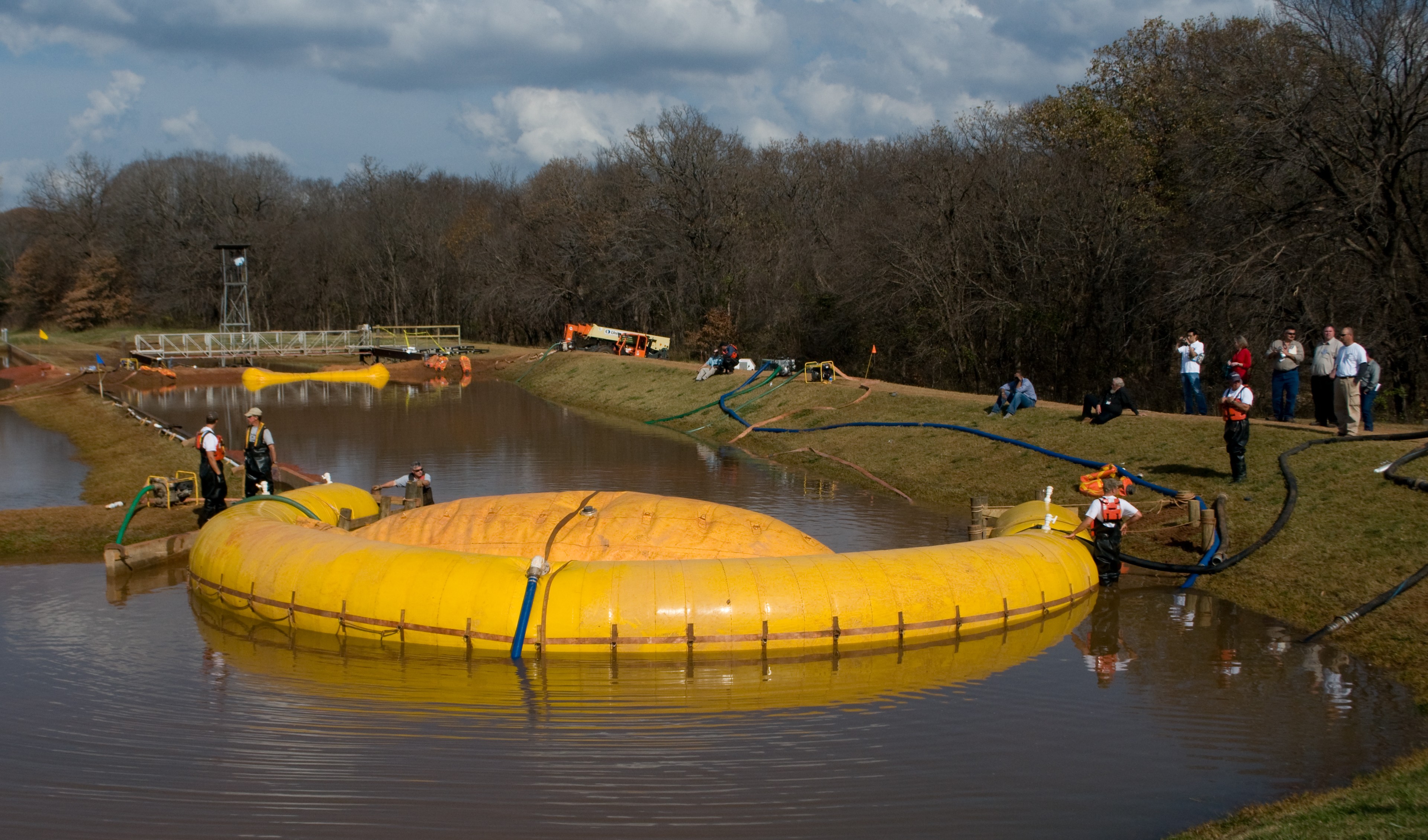STILLWATER, Okla. -- At first glance, the bulky, yellow inner tube scooting downstream resembled a river rapids ride at a theme park.
But this was no ride.
The tube, along with thousands of gallons of water, was gaining speed as it rushed toward a 6-feet-wide breach in the nearby levee. But a few moments later, the tube lodged itself squarely into the levee breach, halting the thousands of gallons behind it and reducing the water flow to a mere trickle.
Saving lives and preventing extensive property damage caused by devastating floods is foremost in the minds of federal agencies charged with providing that protection. Research teams around the country spend countless hours eyeing methods and techniques that might one day significantly reduce the time it takes to seal and repair levee breaches.
A recent demonstration at the U.S. Department of Agriculture's Hydraulic Engineering Research Unit, Agricultural Research Service in Stillwater, provided an informative glimpse of how several devices developed under the Rapid Repair of Levee Breaches Program might work for various sized breaches caused by flooding.
One such technology, developed by a team of research scientists from the U.S. Army Corps of Engineers Engineer Research and Development Center and other agencies, shows promise, even with its bulky exterior.
The RRLB devices are tubes made of non-stretch fabric designed to float into a levee breach, stopping water flow. When dropped into the water, the tube fills roughly 80 percent with water. Kept afloat by the air left in the tube, the device makes its way, pushed by the river flow, to the breach. As it nears the break, the tube begins to roll and eventually locks into place, held by the laws of physics.
"The flexibility of the fabric and the ability to be compliant and fit into an area that we needed it to fit into, all made sense when we started looking at it (material to use)," said Don Resio, senior research scientist at the Corps' ERDC. "These things seal the breach, and it pretty much works first time, every time."
Levee breaches are caused by excessive forces from the water, weakness in the levee material or the levee foundation, or both. Overtopping of levees by floodwater and waves is the most obvious cause. Seepage through or under a levee is less obvious, far more difficult to predict, and is the major concern in certain areas such as the Sacramento-San Joaquin River Delta.
Just how effective RRLB devices would be in flooding scenarios that included the Sacramento or Feather rivers is up for debate. Resio said employing the right-sized tubes with a well-trained team at the right locations could work. A helicopter deployment of the RRLB pieces, coupled with strategic team placement, would likely be used in a flooding event in or near Sacramento.
Resio said that, in a typical scenario, a stock of the tubes - each one in the system is in a pre-loaded configuration - in various sizes would be available and perhaps located at an airport. Once officials realize a breach had occurred, a team would be mobilized.
"(Levees in the Sacramento area) could breach anytime, anyhow. It's more likely to breach during high floods, so you would be on readiness. The team knows what to do, it's trained, and it takes off," Resio continued. "Our goal is to be able to take off within a couple hours of notification, be onsite within an hour, and then have it all set up within another couple of hours."
But there is still much more to consider.
"There are other considerations that could be problems as well," said Ed Ketchum, chief, soil design section, Sacramento District. "Trees, buildings, power lines, etc. may cause mobilization to be very difficult." Developers still need to consider solving several significant technical and logistical problems in order to make the tubes deployable, said Ketchum.
Michael Ramsbotham, soil design expert and regional geotechnical specialist for the Sacramento District, agrees. "You would have to have a small levee with a small breach, with wide open access, and low velocity in the river," Ramsbotham. "I think you could use it (RRLB) to prevent overtopping. If you had a small creek or tributary it would probably work better for that."
Resio said they are still studying the best deployment possibilities and the potential effectiveness for flooding here, knowing the likely difficulty in sealing breaches so large for such a big flood event. But he and his team will continue testing and work toward that end. The key, he said, is that efforts are being made.
He and his team realize the potential obstacles and that this system might not be the solution to every flooding event or breach, but it's a start, he said. "I'm pretty excited about the potential we have with this system," he said. "There's a lot of potential, and there's a lot of good people working in this field. It's amazing how many people and how much everybody wants this thing to succeed. I've very optimistic about transitioning it into what we need it to be."
A full-scale demonstration, likely at a site in South Dakota, will be conducted next summer. The Department of Homeland Security began funding the development and demonstration of the RRLB program in 2007. The initial concept development and testing was accomplished at the facilities of the Coastal and Hydraulics Laboratory, U.S, Amy Engineer Research and Development Center, in Vicksburg, Miss. Additional large-scale testing was completed at the HERU in Stillwater in September 2008.
Related Links:
US Department of Homeland Security
USACE Engineer Research and Development Center








Social Sharing